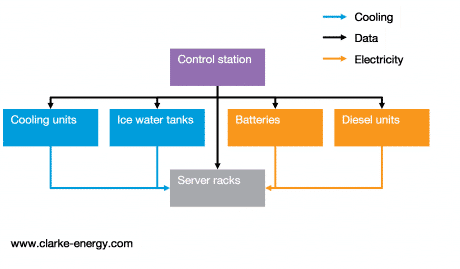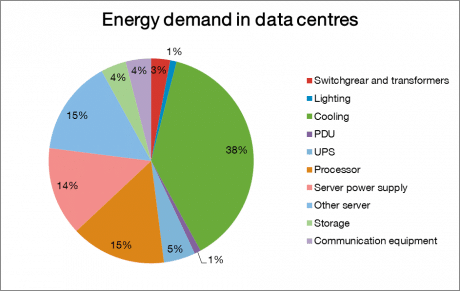Data Centre CHP / Cogeneration
Combined heat and power (CHP) or cogeneration has significant potential in the data centre industry. Electricity and heat recovered from a gas engine captive power plant can be deployed for useful onsite us. Converting the heat into cooling via absorption chillers is called combined cooling and power (CCP) part of the process of or trigeneration, and can be deployed to support the cooling of data centre loads.
Benefits of CHP in data centres
- Energy Cost Savings – Overall efficiencies (electrical and thermal) can reach 95 percent using a wide fuel range Resilient and robust power – You don’t have to rely on the grid alone to ensure your facility has the power it needs 24/7.
- Environmentally friendlier – Less fuel burned per MW generated at lower CO2
- Dry low emission (DLE) technology can sustain lower emission levels while eliminating system water requirements.
- Standardised design – Smaller footprint, scalable to your unique spatial requirements.
- Flexible power – Thermal energy can be stored for use, electricity can be fed into the public grid or used for artificial lighting, and an optional full island lighting control system is available

Characteristics of Data Centres
Data centres went through significant developments in the last decades. In accordance to Moore‘s law, the number of transistors doubled approximately every two years. However, since global data traffic and number of people connected to the world wide web steadily increased, the capacity of data centres grew at least likewise. Depending upon the expected data traffic and equipment to fulfil certain uptime requirements, data centres can either occupy a single building room or be an entire building themselves with up to 25,000 servers and a power draw of tens of MW.
| Factor | Unit | Value |
| Cooling density | kWh/m3 | ~0.75 |
| Average/state of the art PUE | ||
| State of the art WUE | l/kWh/yr | ~0.3 |
| Tier IV availability | % | 99.995 |
Data centres are high electric energy consumers, resulting in very high electric power costs. They require high-quality energy in terms of reliability to ensure continuous operation. Future challenges for data centres are electric load densification and an increase in thermal dissipation of the servers. Thus, assessing the energy usage and energy efficiency is crucial and achieved by measuring metrics such as power us-age efficiency (PUE), meaning the ratio of total facility power to IT equipment power, and water usage effectiveness (WUE). PUE and WUE are especially important, since a data centre’s capacity is usually limited by the performance of cooling system and the total electricity cost rather than by the processor performance.

Data centres are distinguished by their availability classified by tiers: The higher the tier, the more robust and continuous is the data centre’s operation. The uptime requirements rise from 99.671% (Tier 1) to 99.995% (Tier 4). This induces a higher redundancy of the installed components to reach higher tiers. The global amount of digital information created doubles every two years, implying an at least likewise increase in required data centre infrastructure. Thus, it is a must for data centre to be most flexible in terms of expansion and hardware upgrade. In conjunction with upcoming green energy initiatives, high efficiency and a reliable and modular infrastructure are inevitable prerequisites for state-of-the-art data centres.
To learn more about data centre CHP or for us to evaluate your project please submit your enquiry here


